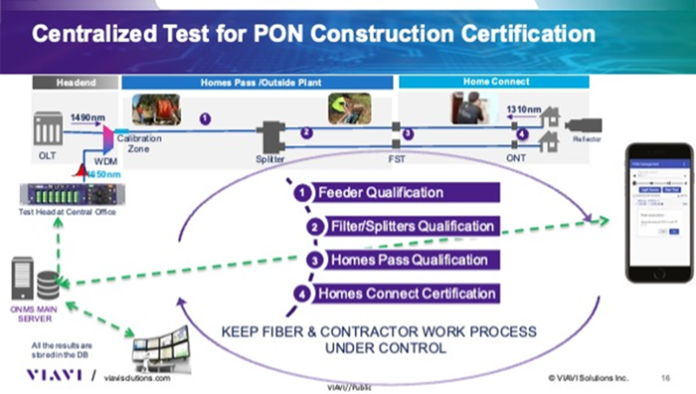
Passive optical networks (PON) have revolutionized connectivity ranging from high-speed fiber-to-the-home (FTTH) to split RAN 5G front-haul deployments. A reliable PON performance in these complex environments requires comprehensive and specialized PON testing tools and processes. With construction, installation, and activation timelines accelerating to meet the growing demand, getting it right the first time has never been more important. Here, we explore a centralized test approach to certify the construction of passive optical networks.
Certification plays a crucial role in PON construction:
- Reliability: PON networks must deliver reliable connectivity to meet customer expectations. Certification ensures that the installed infrastructure adheres to industry standards and performs as intended over the long term.
- Quality assurance: Certification guarantees that the construction process and the materials used adhere to stringent quality standards. This ensures that the network can withstand environmental factors and deliver consistent performance.
- Efficiency: Certification allows network operators to detect and rectify potential issues during the construction phase, minimizing downtime and costly repairs.
- Investment protection: PON build / deployment must deliver long term ROI and value for money.
Lack of comprehensive testing or incorrect test procedures combined with other factors associated with the traditional PON build—like the PON not being built sequentially from the central/local office out and fiber sections being built and connected out of sequence, leads to knock-on effects. To help reduce this knock-on effect and poor customer install success rates caused by poor PON build quality, VIAVI has developed a centralized test application for its remote fiber test system (ONMSi) specifically for PON build certification.
Centralized test for PON build certification
Centralized PON test can be used to characterize, validate and map end-to-end PON remotely from the central office to the termination point (ONT or drop point), allowing the PON to be fully tested during construction. Instead of a tech running around with an OTDR performing tests and storing results in the field for later upload/submission, techs are equipped with optical reflectors with a mobile test app installed on a phone or tablet. The test equipment, essentially a rack mounted OTDR, is installed at the central or local office and managed by a centralized test system, with PON construction application, and connected to the web/cloud for external access. The centralized test approach also requires that PON is built in a logical and sequential order from the central/local office outward to the drop points/terminals. Once the first section of feeder fiber connected to the central/local office has been laid and all the fiber splices made, it can be tested. The tech in the field connects a reflector to the fiber and uses the mobile test app to trigger a remote test from the central/local office, the result of which is automatically stored. If the fiber passes, that fiber/phase of construction is marked as done and complete, allowing real-time reporting on project progress. Next the PON splitters are connected and tests can be run to confirm good feeder fiber to splitter connection.
The same centralized test equipment can be enhanced and expanded with integrated optical switches, so that multiple PONs can be tested with the same equipment, offering coverage efficiencies.
The centralized test approach offers several advantages:
- Simplified Testing Process: Eliminates the need to conduct tests at multiple points in the network, streamlining the certification process for faster and more efficient network certification.
- Compliance to Method of Procedure (MoP): Tests are predefined according to the network design and stage/section/location of the PON being tested, ensuring no deviations.
- 100% certification: Since it saves time (thanks to speed of test, auto result storage/auditing), more fiber can be tested in the same time as the traditional field instrument based approach.
- Efficiency: Any issues or problems with fibers or splices, can be dealt with, before the techs leave a site, reducing the future truck rolls for re-work/mop-up maintenance.
- Enhanced Project Management: The centralized test approach provides a comprehensive view of the network’s construction progress in real-time.
Building a reliable PON require thorough test to assure networks are built as per their design. Comprehensive test and validation helps operators shorten provisioning time, increase quality of service (QoS), and reduce maintenance cost. The centralized test approach is a game-changer for certifying the construction of PON.



















